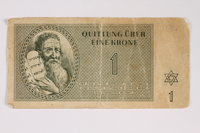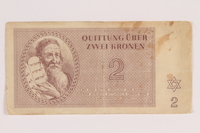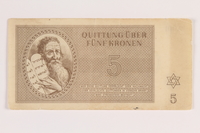Overview
- Description
- Contains fifteen photographs documenting Gustav (Gus) Meyer's experiences in prewar Germany and during his time in Great Britain on the Kindertransports, plus one undated embarkation/landing card.
- Credit Line
- United States Holocaust Memorial Museum Collection, Gift of Gustav (Gus) Meyer
Physical Details
- Genre/Form
- Photographs.
- Extent
-
1 folder
Rights & Restrictions
- Conditions on Access
- There are no known restrictions on access to this material.
- Conditions on Use
- The Museum is in the process of determining the possible use restrictions that may apply to material(s) in this collection.
Keywords & Subjects
- Topical Term
- Kindertransports (Rescue operations)--England.
Administrative Notes
- Holder of Originals
-
United States Holocaust Memorial Museum
- Legal Status
- Permanent Collection
- Provenance
- Donated to the United States Holocaust Memorial Museum in 2011 by Gustav J. Meyer
- Record last modified:
- 2024-02-29 10:25:11
- This page:
- https://collections.ushmm.org/search/catalog/irn43907
Download & Licensing
- Copyright Not Evaluated
- Terms of Use
- This record is not digitized and cannot be downloaded online.
In-Person Research
- Request 7 Days in Advance of Visit
- Plan a Research Visit
-
Request in Shapell Center Reading Room
Bowie, MD
Contact Us
Also in Gustav J. Meyer collection
The collection consists of three Theresienstadt ghetto-labor camp notes, documents, and photographs relating to the experiences of Gustav (Gus) Meyer in prewar Germany and during his journey on a Kindertransport to Great Britain.

Theresienstadt ghetto-labor camp scrip, 1 krone, acquired by Kindertransport refugee
Object
Scrip, valued at 1 (eine) krone, of the type distributed in German occupied Czechoslovakia acquired by Gustav Meyer. Gustav was sent to safety on a Kindertransport from Germany to Great Britain ca. 1938. Inmates in Theresienstadt were not allowed to have currency. The SS ordered the Jewish Council to design scrip for use only in the camp. Notes were printed in 7 denominations: 1, 2, 5, 10, 20, 50, 100. The scrip was issued to create a false appearance of normalcy. There was little to obtain with it. The camp was in operation from November 24, 1941 until early May 1945. Approximately 140,000 Jewish men, women, and children were transferred to Theresienstadt; nearly 90,000 were then deported, likely to their death, further east. About 33,000 Jews died in Theresienstadt.

Theresienstadt ghetto-labor camp scrip, 2 kronen, acquired by Kindertransport refugee
Object
Scrip, valued at 2 [zwei] kronen, of the type distributed in German occupied Czechoslovakia acquired by Gustav Meyer. Gustav was sent to safety on a Kindertransport from Germany to Great Britain ca. 1938. Inmates in Theresienstadt were not allowed to have currency. The SS ordered the Jewish Council to design scrip for use only in the camp. Notes were printed in 7 denominations: 1, 2, 5, 10, 20, 50, 100. The scrip was issued to create a false appearance of normalcy. There was little to obtain with it. The camp was in operation from November 24, 1941 until early May 1945. Approximately 140,000 Jewish men, women, and children were transferred to Theresienstadt; nearly 90,000 were then deported, likely to their death, further east. About 33,000 Jews died in Theresienstadt.

Theresienstadt ghetto-labor camp scrip, 5 kronen, acquired by Kindertransport refugee
Object
Scrip, valued at 5 [funf] kronen, of the type distributed in German occupied Czechoslovakia acquired by Gustav Meyer. Gustav was sent to safety on a Kindertransport from Germany to Great Britain ca. 1938. Inmates in Theresienstadt were not allowed to have currency. The SS ordered the Jewish Council to design scrip for use only in the camp. Notes were printed in 7 denominations: 1, 2, 5, 10, 20, 50, 100. The scrip was issued to create a false appearance of normalcy. There was little to obtain with it. The camp was in operation from November 24, 1941 until early May 1945. Approximately 140,000 Jewish men, women, and children were transferred to Theresienstadt; nearly 90,000 were then deported, likely to their death, further east. About 33,000 Jews died in Theresienstadt.



